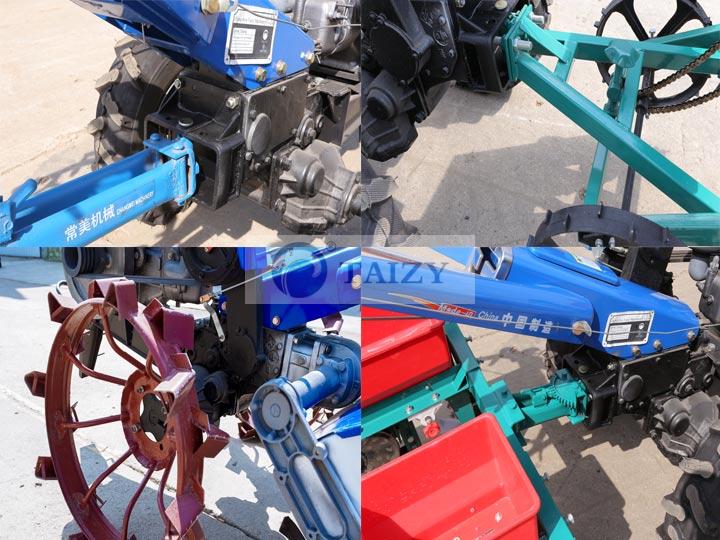A walking tractor is a good helper for farmers. The walking tractor machine with different farm tools can achieve multiple functions. The walking tractor is light, flexible, and easy to operate, and is suitable for operation in different land conditions. Be sure to pay attention to maintenance when the walking tractor is frequently used, and repair it in time when there is a problem. Correct use, maintenance, and repair of your walking tractor are to maximize the benefits of your tractor. Here are a few common faults and maintenance methods for walking tractors.
When a Walking Tractor Fails, It Can Generally Be Judged by “Listening, Seeing, Smelling, and Touching”.
Listen: change the engine speed, listen to whether it is stable at high and low speeds, and whether the exhaust sound is normal.
Look: observe whether there is any change in the exhaust, smoke, oil color, etc., and whether there is oil leakage, air leakage, and water leakage.
Smell: use your nose to smell smoke, burnt smell, and oily smell.
Touch: use your hands to understand the temperature of the water tank, bearing heating, component fixation, and high-pressure oil pipe pulsation.
For some common faults of walking tractors, the troubleshooting methods are respectively introduced below.
Agricultural Machinery Attachments Tools and Walking Tractors Separated
The hooks and bolts of walking tractors are easy to break, so the agricultural tool parts and the tractor are out of joint, and accidents of machine damage occur. Install a new safety hook between the tractor’s towing frame and the tow pipe of the agricultural tool parts to solve it properly. Before each use, check whether the hooks and pins are installed well.
First, weld it into a hook shape with a flat iron with a thickness of 8-10 cm, and then fix it on the farm tool pipe with 4 bolts of 10-12 cm. Make another traction frame pin, install the original hook and the newly made hook on this pin together, and make sure that both hooks can slide up and down, left and right. Then, install two easy-to-disassemble loop chains between the traction frame of the walking tractor and the tractor pipe, so that even if the original traction frame, bolts, or hooks are broken while the walking tractor is running, it is safe to do so.

Incomplete Clutch Separation
The reason is mostly that the clearance between the separating lever ball and the separating bearing is too large or the tie rod is too long. It can be solved according to adjusting the gap or shortening the tie rod. If it is caused by deformation of the friction fins, wear of the clutch shaft, or excessive wear of the working slope of the bearing cover, etc. It can be solved by replacing the friction plate, repairing by electric welding, or replacing the shaft spline and bearing cover.
Auto-off
The reason is that the fork stroke is too small to reach a stable position. You can check the levers, pins, pin holes of the speed control mechanism, and make corrections. Sometimes it may be due to the wear of the positioning steel ball and positioning groove, the weakening of the spring force, the deformation of the gear lever, the deformation of the cover, and the deflection of the gear plate. Replace the steel ball, spring or repair the positioning groove, and correct the gear lever and gear plate.
Brake Failure
It is mostly caused by wear of the brake ring and brake lever cam or improper adjustment of the brake lever and adjustment nut. Parts should be repaired or replaced, and the brake rod and nut should be adjusted.
Walking Tractor Deviation
The reason is mostly inconsistent with tire pressure or inconsistent wear. Inflate the left and right tires to the specified air pressure. If one tire is severely worn, you should consider replacing it.
Electrical Component Failure and Treatment
The reason why the electromagnet does not work is due to poor circuit contact, coil burnout, fuse damage, and rectifier bridge damage. Therefore, usually check the circuit more, find the problem and recover in time, and replace the solenoid coil, fuse core, and rectifier diode in time.
